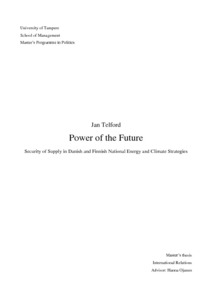Power of the Future: Security of Supply in Danish and Finnish National Energy and Climate Strategies
Telford, Jan (2016)
Telford, Jan
2016
Politiikan tutkimuksen tutkinto-ohjelma - Degree Programme in Politics
Johtamiskorkeakoulu - School of Management
This publication is copyrighted. You may download, display and print it for Your own personal use. Commercial use is prohibited.
Hyväksymispäivämäärä
2016-06-23
Julkaisun pysyvä osoite on
https://urn.fi/URN:NBN:fi:uta-201607202095
https://urn.fi/URN:NBN:fi:uta-201607202095
Tiivistelmä
Each country in the world is currently under pressure to find other means than fossil fuels to satisfy its energy needs, as the legally binding Paris Agreement urges to limit global warming to 2 degrees Celsius. Denmark and Finland were part of the Kyoto Protocol, and as part of the EU, agreed earlier on targets on their emissions, energy efficiency, and renewable energy. Although these countries were at the forefront to combat climate change, they are still far away to complete the transition of their energy systems.
This thesis analyses Danish and Finnish national energy and climate strategies. The study asks how will Denmark and Finland ensure their security of energy supply as energy and climate targets necessitate to replace all fossil fuels until 2050. It applies a social structurationist approach to develop a theoretical framework to answer the question of why have these countries chosen exactly the means they are currently employing.
Through comparative case study approach this study shows that there are both major similarities and differences in Danish and Finnish energy strategies. Both countries expand the production of bio-based energy sources, and strive to reduce energy consumption through energy efficiency measures. However, Denmark considers wind power a financially viable energy source and crucial for its future energy mix, whereas Finland views it as a complimentary alternative. Finland relies on nuclear energy for the foreseeable future, in contrast to Denmark which gives the technology no part in its energy planning. This divergence highlights how the EU in general is divided in regard to nuclear power.
This thesis finds Denmark more ambitious than Finland in light of energy and climate targets. Finland deems further technological development, especially the commercialisation of carbon capture and storage, necessary to reach the long-term targets.
This thesis analyses Danish and Finnish national energy and climate strategies. The study asks how will Denmark and Finland ensure their security of energy supply as energy and climate targets necessitate to replace all fossil fuels until 2050. It applies a social structurationist approach to develop a theoretical framework to answer the question of why have these countries chosen exactly the means they are currently employing.
Through comparative case study approach this study shows that there are both major similarities and differences in Danish and Finnish energy strategies. Both countries expand the production of bio-based energy sources, and strive to reduce energy consumption through energy efficiency measures. However, Denmark considers wind power a financially viable energy source and crucial for its future energy mix, whereas Finland views it as a complimentary alternative. Finland relies on nuclear energy for the foreseeable future, in contrast to Denmark which gives the technology no part in its energy planning. This divergence highlights how the EU in general is divided in regard to nuclear power.
This thesis finds Denmark more ambitious than Finland in light of energy and climate targets. Finland deems further technological development, especially the commercialisation of carbon capture and storage, necessary to reach the long-term targets.
